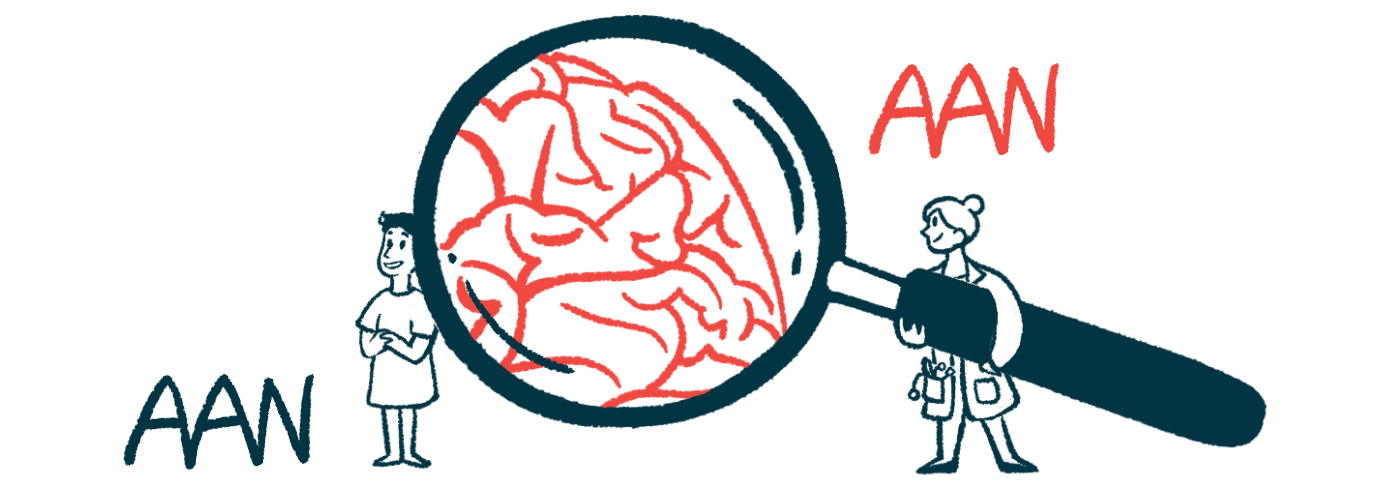AAN2024: No relapses with Ultomiris after more than 2.5 years
In earlier PREVENT study, nearly half of patients on placebo saw relapses

None of the neuromyelitis optica spectrum disorder (NMOSD) patients in the Phase 3 CHAMPION-NMOSD clinical trial have had a disease relapse while on Ultomiris (ravulizumab-cwvz) treatment for a median of more than 2.5 years.
These findings were shared by Sean Pittock, MD, the trial’s principal investigator, at the American Academy of Neurology (AAN) 2024 Annual Meeting, being held April 13-18, in Denver and online. The work was funded by Ultomiris’ developer, now named Alexion, AstraZeneca Rare Disease. Pittock’s presentation was titled “Efficacy and Safety of Ravulizumab in Adults With Anti-Aquaporin-4 Antibody-Positive Neuromyelitis Optica Spectrum Disorder (AQP4+ NMOSD): Interim Analysis From the Ongoing Phase 3 CHAMPION-NMOSD Trial.”
“Just one NMOSD relapse can lead to permanent disability for patients, like vision loss or paralysis, which is why we strive to prevent relapses with treatment,” Christophe Hotermans, MD, PhD, senior vice president and head of global medical affairs at Alexion, wrote in an email to Neuromyelitis News. “New data presented at AAN 2024 from our CHAMPION-NMOSD trial showed zero relapses were observed in patients with a median treatment duration of 138 weeks, reinforcing the long-term clinical benefit of Ultomiris in the prevention of relapses in NMOSD.”
NMOSD is an autoimmune disease wherein self-reactive antibodies attack healthy cells in the brain and spinal cord. These antibodies typically target aquaporin 4 (AQP4), a protein highly present in nerve-supporting cells called astrocytes. The disease is marked by relapses, or flares, where symptoms suddenly get worse. Preventing these relapses is a major goal of treatment.
Ultomiris is approved for adults with NMOSD who are positive for anti-AQP4 antibodies. It blocks C5, a component of a part of the immune system that contributes to NMOSD-driving autoimmune attacks.
Alexion’s older NMOSD treatment Soliris (eculizumab) also suppresses C5. Both are given by infusion into the bloodstream, but Ultomiris was developed to allow less frequent dosing. Maintenance doses of Ultomiris are given every eight weeks, versus every two weeks with Soliris.
Decline in relapse risk with Ultomiris
Ultomiris’ approvals were based mainly on data from CHAMPION-NMOSD (NCT04201262), an ongoing Phase 3 trial that enrolled 58 people with AQP4-related NMOSD, all of whom had at least one relapse in the prior year. As there were already several NMOSD treatments available when the trial was launched, it was considered unethical to include a placebo group,and all the participants were treated with Ultomiris.
To contextualize the findings, the results were compared with data from patients who got a placebo in the Phase 3 PREVENT trial (NCT01892345), whose data supported approvals of Soliris for AQP4-related NMOSD.
CHAMPION-NMOSD topline data, announced after all the participants completed or discontinued treatment after nearly a year, showed none of them had relapses for up to more than two years. This represented a 98.6% lower risk of relapse relative to the external placebo group in PREVENT.
All but two participants elected to enter CHAMPION-NMOSD’s extension phase, where they are taking Ultomiris for up to two more years.
New results from June 2023 showed no relapses have been documented with Ultomiris for a median of 138.4 weeks, or slightly longer than 2.5 years, and up to 183.1 weeks, about 3.5 years. In PREVENT, nearly half the patients given a placebo saw relapses after about two years.
This corresponded to a 98.9% drop in the risk of relapse with Ultomiris versus a placebo.
For most patients, measures of walking ability and disability, namely the Hauser Ambulation Index (HAI) and the Expanded Disability Status Scale (EDSS), remained stable. Only five patients had clinically meaningful worsening on these measures and six reported improvements on the HAI.
“Most patients treated with [Ultomiris] demonstrated stable or improved disability measures through the longer-term 138.4-week median follow-up,” the researchers said. “Together, these findings demonstrate the long-term clinical benefit of [Ultomiris] in the prevention of relapses in patients with [AQP4-related] NMOSD.”
Ultomiris’ safety profile remained consistent with prior analyses, with “no new safety signals in the long-term extension” Pittock said. Ultomiris is known to increase the risk of serious and potentially fatal meningococcal infections. Two of these infections were reported in the topline data, but none have occurred in the extension period so far.
Biomarker data from CHAMPION-NMOSD
In a separate talk at AAN, Dean Wingerchuk, MD, of Mayo Clinic, shared new analyses of biomarker data from the CHAMPION-NMOSD and PREVENT studies in a presentation titled “Evaluation of Glial Fibrillary Acidic Protein (GFAP) and Neurofilament Light Chain (NfL) Levels During Eculizumab and Ravulizumab Treatments in Aquaporin-4-Positive (AQP4+) Neuromyelitis Optica Spectrum Disorder (NMOSD).”
Wingerchuk’s presentation focused on blood levels of the proteins neurofilament light chain (NfL), a nerve damage biomarker, and glial fibrillary acid protein (GFAP), a marker of astrocyte damage.
Data from both trials showed that, before starting treatment, average levels of NfL and GFAP were higher in NMOSD patients than in people without the neurological disease.
Available data suggest Ultomiris reduces levels of both markers over time, while Soliris reduces levels of GFAP alone, and “appears to attenuate the increase in [blood] GFAP that occurs during an attack compared to placebo,” Wingerchuk said.
The findings suggest Ultomiris or Soliris can lessen the damage to brain cells that drives NMOSD symptoms, the researchers said.
The data suggest GFAP and NfL “may be additional indicators of treatment efficacy for NMOSD,” Hotermans said, adding the results “support future research.”







